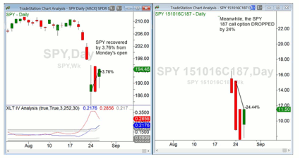Though puts tend to go up when stock prices go down and calls tend to go up when stock prices go down, this is not always the case, so options instructor Russ Allen, of Online Trading Academy, outlines the rules and exceptions to this tendency, citing the market's price action several weeks ago as a good example.
Most people who have heard of put and call options know that they can be used to make money from stock movement. Puts tend to go up when stock prices go down. Calls tend to go up when stock prices go up.
The important phrase in the above sentence is “tend to.” It is not guaranteed that call prices will go up when stock prices do. People who know the rules and the exceptions to this tendency can do very well by trading options. Those who don’t can get some unpleasant surprises.
A good example was the slam-bam market two weeks ago (end of August 2015). Note the charts below:
In the left-hand chart we see a daily plot of the price of SPY, the ETF that tracks the S&P 500 index. SPY made a big drop over the weekend of Friday, August 21, to Monday August 24. After closing on Friday around $198, it opened on Monday around $187. From that dismal open it clawed its way partway back over the next three days and closed on Wednesday around $195. This was a recovery of 3.76%. This partial recovery was small comfort for anybody who owned SPY before the drop, but an improvement in any case off the bottom.
Now note the right-hand chart. This is the price of a call option, the right to purchase SPY at $187. This strike price was chosen because $187 was SPY’s opening price on Monday after the weekend crash. Say that a trader somehow had inside information that the bottom of the market was in and bought this call option as the market opened on Monday. Knowing that calls go up when stocks go up, the trader figured that this was a low cost way to trade the bounce. The cost of the call at that time was $15.22 per share.
Imagine the trader’s surprise two days later: He had been exactly right about the market and SPY was up by almost 4%. In normal times this should have led to an increase in the value of the calls of several times that 4%. Yet the calls were actually down by 24%. What happened?
The answer is, changing expectations. In the option world we refer to this as implied volatility. On Monday morning people who were buying options were paying crazy prices. They were behaving as though the recent rate of change was going to continue. This was a state of high implied volatility.
This is the usual reaction when stock prices drop suddenly. Some people are frantic to buy put options to protect themselves and will pay high prices for that protection. This drives the prices of that stock’s call options up as well. This may seem perverse since call options are a bullish instrument, but it is true. If it were otherwise—and only put options became more valuable when people were nervous—then risk-free profits would be possible. The exact mechanism is beyond the scope of this article; suffice it to say that fear makes both put and call options more expensive.
When the fear dissipates, people return to their senses and are no longer willing to pay such high prices for options. This was the case by Wednesday afternoon. The crisis had passed (at least for the moment). The drop in option prices due to the decline in the fear factor more than overcame the effect of the rise in the stock price.
A properly educated option trader would have known better than to buy call options at a time like this. There are definitely ways to use options profitably in such a situation when you know how. Don’t be an option trader who knows just enough to be dangerous.
By Russ Allen, Instructor, Online Trading Academy






















